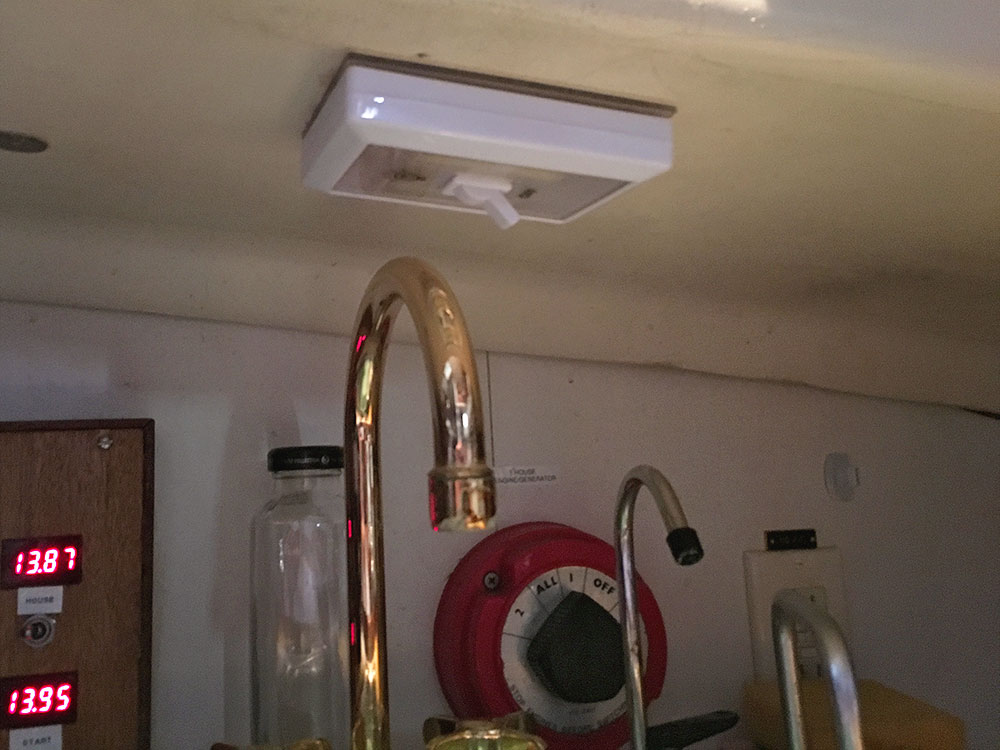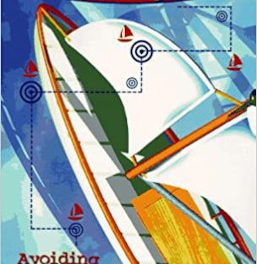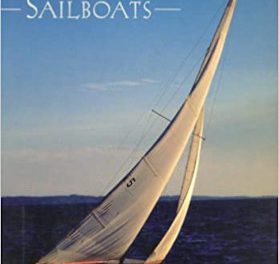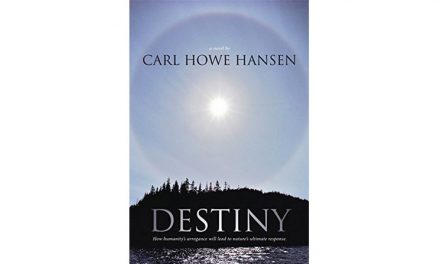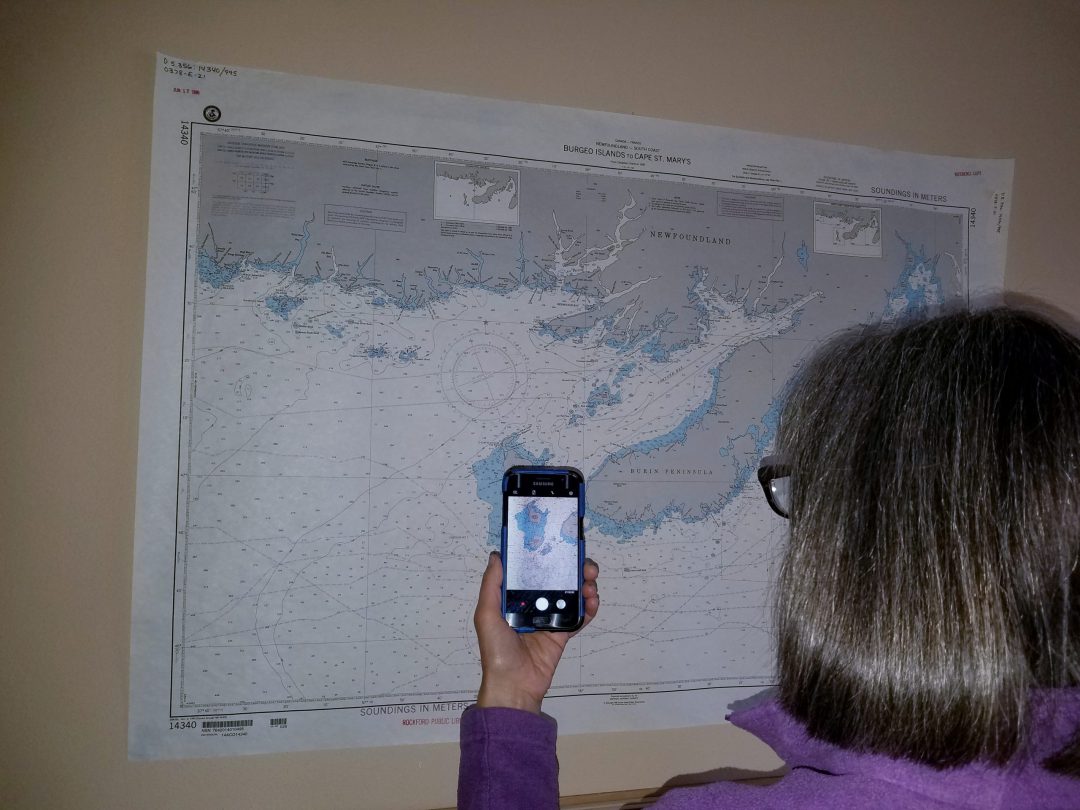
Highly Questionable
I could not believe that you published this short article (“Easy Charting,” February, The Dogwatch). Taking a picture of a chart on a smartphone? Really? While I’m not sure, I strongly suspect that this same publication has written articles on chartplotting apps for a smart phone. They are cheap! And far more accurate than a not-to-scale picture, and far more useful!
Yes, I can see that a shot of a chart that one is familiar with may make one feel better, but it’s use as a navigational aid is highly questionable.
—Kirk Haverland

Forget how he navigates, we’re more concerned about how Allen steers his MacGregor.
Thanks for the feedback, Kirk. We assume you don’t object to Allen using whatever tools he uses to get to where he’s going, but that you object to us publishing Allen’s story because it amounts to a tacit endorsement of Allen’s approach to navigation. For the record, our decision to publish anything should not be considered our endorsement of anything.
That said, we salute Allen’s sense of thrift and fully endorse his navigation hack. Why not? It’s just another tool, as Allen makes clear, in his arsenal. And he spelled out the advantages it offers him. Reading his story, we don’t think Allen’s under any delusion that his navigation hack is superior or on par with even a smartphone navigation app, it’s just another tool.
Frankly, Allen’s hack impressed us, but we’re easily impressed. We’re the type that would leave the cold drizzle topsides to duck into the cabin for the third time in 30 minutes to again read the description in the guidebook about the pass we’re about to enter, and never once would it occur to us to take the damn phone out of our pocket and take a picture of the description. Thanks to Allen, maybe we will in the future. –Eds
Books to Booze
I expect you’ll hear from more than one of your readers that “Minding your P’s and Q’s” has only recently been twisted to serve as a salty and boozy reference. Some of us are old enough to have suffered through typesetting class in our youth. The lowercase letters b, d, p, and q are all mirror images flipped on one axis. The letter is necessarily backwards when viewed in your hand before being placed in the composing stick upside down, from left to right. The letters b and d were used frequently enough that mistakes were rarely made, but the p and q were quite often reversed and need a second look. Backwards and upside down. It’s a case of publishing trivia pirated by the wet set!
—Bob Taylor, Juniata Lily, 1979 Gulfstar 37, Worton, Maryland
Thanks, Bob. We only heard from you on this, but we love it! –Eds.
Coming to an Ocean Near You
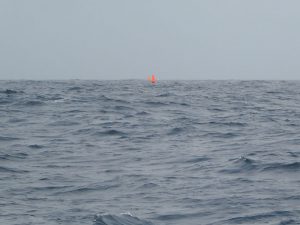
The sail drones are also in the mid-Atlantic (“News From the Helm,” February, The Dogwatch). Here is a photo of one taken from my boat during the West-to-East Transatlantic Race 2019.
—Hiro Nakajima
Electron Concerns
As a 76-year-old avid sailor of limited experience, it’s unlikely that I will ever do offshore sailing, or even sailing in unfamiliar waters. In large part due to my personality (and age), I lean toward the paper chart side. Those who are strongly on the GPS side should read Ghost Fleet by Singer and Cole. It is a story set during WWIII and regardless of whether a reader is tech-reliant or not, I think they’ll find it a great, even frightening, read.
—Cary Andras
Thanks Cary. We’re still planning to dive deep on this topic in “The View From Here,” in the May issue of Good Old Boat—stay tuned… –Eds.
Starboard, Sterbord, Blada Bord, Laddebord
I expect you have received numerous comments regarding port and starboard after the letters in the February and January Dogwatches (Nautical Trivia in January’s The Dogwatch). For what it’s worth, following is my take on the subject.
Starboard is the right side of a vessel when facing forward. Viking ships had their steering oars on the starboard side. The earlier terms are recognizable today in the old northern languages with stearbord, the Anglo-Saxon word, and later sterbord in Middle English.
Port, the left side of the vessel when facing forward, was the side to the dock to avoid damage to the steering oar or its fittings. The Old Norse word was blada bord or loading side and in Middle English it became laddebord. Because of the risk of confusion in spoken orders in the 1840s, the Royal Navy changed larboard to port. They were followed a couple of years later by the U.S. Navy. Port, in the sense of an opening in a rail or bulwark for loading cargo, can be traced back to the Old French and Middle English porte, and earlier to the Latin porta, a gate or an opening.
An aside : On my Old Town 20-foot sailing canoe, the paddle was required to assist in tacking until I fitted a Viking-style steering oar, to starboard of course, that could be swung up for beaching. The high-aspect ratio, deep-draft oar made tacking a breeze.
—Jay Paris
Good to hear from you, Jay. We’ve got one more this month in addition to you (below), but we love it, the more trivia, the better. Anyone else? —Eds.
This might be the answer to your query. In navigation, the terms port and starboard are used to qualify the left and right of a boat, respectively. The origin of these terms comes from the Dutch: port side means that we have our back to the side (bakboord, bak meaning “back” and boord “side”) and starboard (stierboord) facing the scull (right). In the 15th century, when the French appropriated the terms, ships were still often maneuvered from the stern with a scull. The scull was indeed used on old boats and located on the right side as most sailors were right-handed. The helmsman facing this scull therefore turned his back to the left side. Possible?
—R. Dandurand
Lost and Found
Last month, I put it to the readers about lost items overboard, about things recovered, things not. About things found while diving. I knew there had to be a few good stories out there, on par with our recovery of the FBI agent’s gun. And there are. I’ll give Bill White the first word because with his last name, he’s already endured a lifetime of going last…
—Michael Robertson, Editor
***
It was December 5, 1977. We were anchored in Francis Bay, off St John in the U.S. Virgin Islands, enjoying pre-sundowners after a great sail from St Thomas. Coming our way was a sport fisher with a massive tuna tower and a huge bow wave. We were the only boat anchored in Francis Bay, but the sport fisher was aimed right at us. This got our attention, all of it.
Now, in those days, all of us in the Caribbean carried a conch horn because, well, it was the 1970’s, and canned-air horns didn’t last and the conch never wore out. We started blowing that conch as if our lives depended on it, which looking back, they kind of did. At the same time, I started the engine and spun the wheel to port. I was just getting ready to hit the throttle, hoping he would go to starboard of us, when a head popped up on the fly bridge and the sport fisher turned to starboard and pulled the throttles off.
As we rolled gunnel to gunnel in the wake, we stared down the sport fisher with disbelief. A man aboard the sport fisher walked to the bow, picked up a huge Danforth, yelled back and forth with someone on the bridge, then heaved the anchor overboard, almost exactly where our anchor was lying 150 feet off our bow. Our mouths agape, the sport fisher started backing down, fast, right by us.
They continued for quite the distance before they must have realized there was a problem. They put the boat in forward and motored back up to us. That’s when someone aboard started shouting questions at us, in a language none of us could speak, despite having English, French, Vietnamese, and German between us. We guessed it was Spanish.
Fed up with us, they motored around for a while before hitting the throttles and heading back for St. Thomas. We got the snorkels and fins out and hit the water. We followed our anchor chain out to our 45-pound plow and lying right next to it was that big old Danforth. We rigged up a life jacket to it and got it back to the boat. With another round of sundowners in hand, we examined our prize. It was a 65-pound high-tensile Danforth anchor with a label on one of the flukes and a price tag wired to the shackle hole.
I carried that anchor from one end of the Caribbean to the other until 1982, when we sold the boat. I used it only twice, once for Hurricane David and a week later for Fred.
—Bill White
As a much younger man, after taking a lovely young woman out for a sail on my home-built Atkins Economy Jane, a 21-foot gaff-rigged sloop, she dropped her sunglasses into the murky water of the Long Beach Marina in Southern California.
“You’re a diver, aren’t you?” She asked coyly. I explained that I had no scuba gear, that the visibly was near zero, and the bottom was a cloud of muck. But she was a good prospect for whom a heroic recovery might just be the icing on the cake that was the beautiful afternoon of whale watching her intrepid captain had just given her. So, against all odds, I leapt.
Diving awkwardly between the dock and hull, I gave a few strong kicks and arrived at the bottom sooner than I expected, and which, given the murk, didn’t see coming. My hands plunged into the silt, stirring up a cloud that reduced the visibility to zero. About to pull up, already preparing my apologies and excuses, I felt something beneath my right hand. I closed my grip, shook off the muck and was amazed as I started toward the surface to realize that I was holding her glasses.
I emerged, handed them to her and took full credit for fickle fate as I basked in her admiration.
—Nesdon Booth
I was diving on a wreck off the coast of Pensacola many years ago. On the sandy bottom, some distance from the wreck, I found a wallet with a driver’s license and a hundred-dollar bill. It belonged to a local restaurant owner. When I returned it to him, he offered me a free meal (I never returned to claim it) and told me the story.
He had tied his motorboat off to the wreck (which at low tide had parts of it exposed) and went diving. Unfortunately for him, he had very little “scope” on the rope he used to tie off with. When he surfaced, the tide had risen, pulling his runabout under, sinking it. Fortunately, others were in the area and got him home. His boat was eventually recovered, but his wallet had remained missing, until I turned up.
—Kevin McGhee
I was a liveaboard on Oregon’s Willamette River, rowing back to my boat. I had my outboard with me and, where better to stow it than the transom? And why dog it down if I’m only going to remove it when I get back to the boat? Well, the wake came out of nowhere and my outboard slid off the transom and into the drink, the beginning of a quick 30-foot trip to the bottom. It happened as though in slow motion, but too quickly for me to save it. I was devastated and ashamed of myself, but had the presence of mind to toss overboard a small stern anchor and a line attached to a fender, to mark the spot.
I lived on a section of the river labeled a Superfund Site by the EPA, and I knew from experience that local divers charged a fortune for recoveries here.
After several days of mulling over solutions, I decided to free dive for my motor. The only problem was that I had never free dove deeper than to the bottom of a swimming pool, and even then I would get painful pressure in my ears. How did free divers do it?
I looked online and learned that equalizing was the key. I was ready.
My friend Daniel came by to assist. “If you drown, I’ll make sure the authorities pull your body out for a proper burial.”
I made the first free dive attempt and practiced equalizing at around ten feet down. What a difference it made! My ears and head didn’t ache. The second dive I went a little deeper but got spooked out by how dark it was around 20 feet. It was the third attempt that I finally reached the bottom. Even though it was a bright, sunny day, the visibility nill. But I swam back to the surface with a newfound confidence that I could go back to the bottom and begin the search.
On the next dive, I brought with me a 100-foot length of ¼-inch line that I secured to the boat. Once on the bottom I started exploring. It didn’t take long before I spotted my outboard sitting on the bottom, on its side. I quickly ran the line through its handle and swam back to the surface. Then, from the dinghy, I pulled my outboard to the surface, hand over hand.
Daniel was ready. “Ya know, I think those Honda fish are catch and release.”
—Justin (aka Captain Cupcake), Portland, Oregon
My wife, Marty, and I were vacationing in East Boothbay in the early 1970s and took a drive out to visit my childhood summer home on Barter’s Island. We stopped at a small beach area, nestled near the road on the Back River. The sun had warmed the water to the point that we were able to enjoy a swim, splashing around. When I discovered that my wedding ring was missing from my finger, we both search the bottom below the murky water with our toes until we were sure it was hopeless. Disheartened, we departed for our rental cottage.
Later that day, on a whim, I suggested we go back, reasoning that maybe we’d see something at low tide. Pulling into the small parking lot next to the beach, we saw a couple sitting together. As we walked past them to the water, one of them asked, “Did you lose something?”
We explained, and they pulled the ring out, said they had discovered it and were waiting there, hoping the owners would return. Wow! Fifty years later, I still have same ring, somewhat loose on my finger, but now I always put it in a safe spot before any outdoor activity.
—Nick Amdur, 1987 Caliber 28, Hingham, Massachusetts


